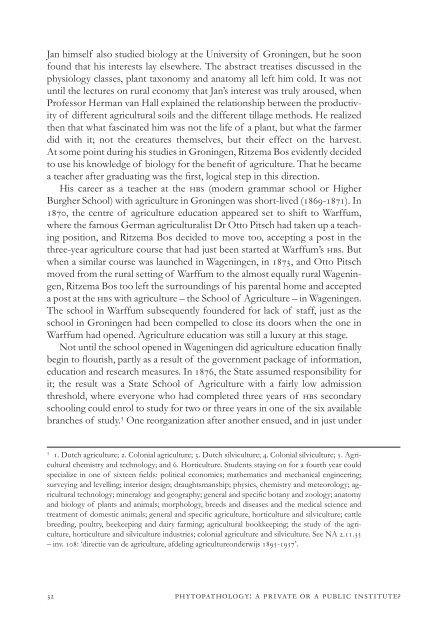PDF (full volume) - DWC - KNAW
PDF (full volume) - DWC - KNAW
PDF (full volume) - DWC - KNAW
Create successful ePaper yourself
Turn your PDF publications into a flip-book with our unique Google optimized e-Paper software.
Jan himself also studied biology at the University of Groningen, but he soon<br />
found that his interests lay elsewhere. The abstract treatises discussed in the<br />
physiology classes, plant taxonomy and anatomy all left him cold. It was not<br />
until the lectures on rural economy that Jan’s interest was truly aroused, when<br />
Professor Herman van Hall explained the relationship between the productivity<br />
of different agricultural soils and the different tillage methods. He realized<br />
then that what fascinated him was not the life of a plant, but what the farmer<br />
did with it; not the creatures themselves, but their effect on the harvest.<br />
At some point during his studies in Groningen, Ritzema Bos evidently decided<br />
to use his knowledge of biology for the benefi t of agriculture. That he became<br />
a teacher after graduating was the fi rst, logical step in this direction.<br />
His career as a teacher at the hbs (modern grammar school or Higher<br />
Burgher School) with agriculture in Groningen was short-lived (1869-1871). In<br />
1870, the centre of agriculture education appeared set to shift to Warffum,<br />
where the famous German agriculturalist Dr Otto Pitsch had taken up a teaching<br />
position, and Ritzema Bos decided to move too, accepting a post in the<br />
three-year agriculture course that had just been started at Warffum’s hbs. But<br />
when a similar course was launched in Wageningen, in 1873, and Otto Pitsch<br />
moved from the rural setting of Warffum to the almost equally rural Wageningen,<br />
Ritzema Bos too left the surroundings of his parental home and accepted<br />
a post at the hbs with agriculture – the School of Agriculture – in Wageningen.<br />
The school in Warffum subsequently foundered for lack of staff, just as the<br />
school in Groningen had been compelled to close its doors when the one in<br />
Warffum had opened. Agriculture education was still a luxury at this stage.<br />
Not until the school opened in Wageningen did agriculture education fi nally<br />
begin to fl ourish, partly as a result of the government package of information,<br />
education and research measures. In 1876, the State assumed responsibility for<br />
it; the result was a State School of Agriculture with a fairly low admission<br />
threshold, where everyone who had completed three years of hbs secondary<br />
schooling could enrol to study for two or three years in one of the six available<br />
branches of study. 5 One reorganization after another ensued, and in just under<br />
5 1. Dutch agriculture; 2. Colonial agriculture; 3. Dutch silviculture; 4. Colonial silviculture; 5. Agricultural<br />
chemistry and technology; and 6. Horticulture. Students staying on for a fourth year could<br />
specialize in one of sixteen fi elds: political economics; mathematics and mechanical engineering;<br />
surveying and levelling; interior design; draughtsmanship; physics, chemistry and meteorology; agricultural<br />
technology; mineralogy and geography; general and specifi c botany and zoology; anatomy<br />
and biology of plants and animals; morphology, breeds and diseases and the medical science and<br />
treatment of domestic animals; general and specifi c agriculture, horticulture and silviculture; cattle<br />
breeding, poultry, beekeeping and dairy farming; agricultural bookkeeping; the study of the agriculture,<br />
horticulture and silviculture industries; colonial agriculture and silviculture. See NA 2.11.35<br />
– inv. 108: ‘directie van de agriculture, afdeling agricultureonderwijs 1895-1957’.<br />
32 phytopathology: a private or a public institute?

















